Viz Specifikace pro podrobnosti o produktu.

BD237STU
Product Category: Semiconductor
Basic Information Overview: - Category: NPN Power Transistor - Use: Amplification and switching of electronic signals - Characteristics: High voltage, high current capability - Package: TO-220AB - Essence: Power transistor for general-purpose applications - Packaging/Quantity: Typically available in reels or tubes containing multiple units
Specifications: - Voltage - Collector Emitter Breakdown (Max): 45V - Current - Collector (Ic) (Max): 2A - Power - Max: 36W - DC Current Gain (hFE) (Min) @ Ic, Vce: 25 @ 500mA, 4V - Transition Frequency (Typ): 3MHz
Detailed Pin Configuration: The BD237STU transistor typically has three pins: 1. Emitter (E): Connected to the N-type material 2. Base (B): Controls the flow of current between collector and emitter 3. Collector (C): Connected to the P-type material
Functional Features: - High voltage capability - Fast switching speed - Low saturation voltage
Advantages: - Suitable for a wide range of general-purpose applications - Robust construction for reliable performance - Can handle moderate power levels
Disadvantages: - Relatively low transition frequency compared to some alternatives - May not be suitable for high-frequency applications
Working Principles: The BD237STU operates based on the principles of bipolar junction transistors. When a small current flows into the base terminal, it controls a much larger current flowing between the collector and emitter terminals. This allows the transistor to amplify or switch electronic signals.
Detailed Application Field Plans: - Audio amplifiers - Power supplies - Motor control circuits - LED drivers
Detailed and Complete Alternative Models: - BD238STU - BD239STU - 2N3055 - TIP31C
This comprehensive entry provides an in-depth understanding of the BD237STU semiconductor, covering its category, basic information overview, specifications, pin configuration, functional features, advantages and disadvantages, working principles, detailed application field plans, and alternative models.
[Word Count: 309]
Seznam 10 běžných otázek a odpovědí souvisejících s aplikací BD237STU v technických řešeních
What is the BD237STU transistor used for?
- The BD237STU transistor is commonly used for general-purpose amplification and switching applications in electronic circuits.
What are the key specifications of the BD237STU transistor?
- The BD237STU is a PNP bipolar junction transistor (BJT) with a maximum collector current of 2A, a maximum collector-emitter voltage of 45V, and a maximum power dissipation of 36W.
Can the BD237STU be used for audio amplifier circuits?
- Yes, the BD237STU can be used in audio amplifier circuits due to its ability to handle moderate power levels and currents.
Is the BD237STU suitable for use in low-frequency switching applications?
- Yes, the BD237STU is suitable for low-frequency switching applications such as relay drivers and low-power motor control.
What are the typical operating conditions for the BD237STU transistor?
- The BD237STU transistor typically operates within a temperature range of -65°C to 150°C and requires a base current of 100mA for proper saturation.
Can the BD237STU be used in high-temperature environments?
- The BD237STU has a maximum operating temperature of 150°C, making it suitable for many industrial and automotive applications.
What are some common alternatives to the BD237STU transistor?
- Common alternatives to the BD237STU include the BD238STU, BD239STU, and BD240STU transistors, which offer similar characteristics and performance.
Does the BD237STU require a heat sink for certain applications?
- Depending on the specific application and power dissipation requirements, the BD237STU may benefit from a heat sink to ensure optimal thermal management.
Are there any special considerations for driving the BD237STU in a circuit?
- It's important to ensure that the base current and voltage are within the specified limits to avoid damaging the transistor and to achieve the desired performance.
Where can I find detailed application notes and reference designs for the BD237STU?
- Detailed application notes and reference designs for the BD237STU can be found in the manufacturer's datasheet, technical documentation, and online resources related to BJT transistor applications.

